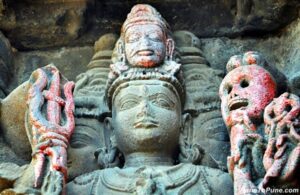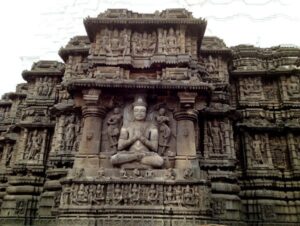S
Shruti Dasgupta
Guest
Aundha Nagnath Jyotirlinga temple is a lesser-known abode of Bhagwan Shiva. A quaint
village in the Hingoli district of Maharashtra houses this sacred home of Lord Shiva as one of
his 12 Jyotirlinga forms. While not as widely recognized as Kedarnath or Somnath, Aundha
Nagnath holds deep spiritual significance for devotees who seek solace and blessings from
the Supreme Being.

PC YatraDham Blog
Enveloped in Sanatani legends, the history of Aundha Nagnath Temple traces back to ancient times. The first known record of the temple’s construction has its roots in Mahabharata. Yudhishthira, the eldest Pandava brother, built this temple during the Pandavas’ period of exile.
Some legends claim that Bhagwan Krishna himself visited this holy site to perform ‘tapa’. Thus, his tapasya at this temple imbibes the air and land with the divine presence of two from the cosmic trilogy!!!

PC punetopune.com
In this eighth Jyotirlinga, Bhagwan Shiva is revered as “Nagnath”. The Jyotirlinga is a ‘SwayambHu’ or self-manifested. It radiates divine energy and blessings to all who seek refuge in its sacred precincts.

PC Dhaara
The written records of the Aundha Nagnath Temple show that the temple existed in its prime form in the 13th century. This construction reflected the Hemadpanthi design. Unfortunately, the rampage of Aurangzeb against Hindus and their places of worship extended to this sacred temple as well. The temple was destroyed on the orders of Aurangzeb, similar to Kashi’s Gyanvapi Temple!

PC NativePlanet
The current temple is 7200 square feet in size. Its Shikhar stands tall at 60 feet. The temple grounds cover an area of 60,000 square feet. The rebuilt temple shines resplendent with exquisite carvings. Since the upper portion was restored it was rebuilt in the Peshwa-era style. Thankfully, the original construction of the Hemadpanthi design is still present in its base.
Many ‘sants’ of Sanatana Dharma found their way to this divine temple. Sant Namdev met his guru, Visobha Khechara, at the Aundha Nagnath Mandir. Guru Nanak also took a spiritual journey to this Jyotirlinga temple. Devotees believe that offering prayers and performing rituals at this Jrotirlinga Temple can help alleviate suffering, cleanse the soul of impurities, and bestow divine grace upon the worshippers.
Lord Shiva in his Jyotirlinga form absorbs the prayers of seekers and grants them spiritual enlightenment & inner peace in return. Unlike many other Shiva Mandirs, here the lingam does not reside in the garbha griha beside the sabha mandapam. A small garbha griha beneath the larger one houses the Shivalinga. This shiva lingam is composed of sand and has the shape of a Shaligram. During an abhishekam, the silver-covered lingam can be touched with ease.
As the 8th among the 12 sacred Jyotirlinga temples dedicated to Bhagwan Shiva, Aundha Nagnath Temple embodies the cosmic harmony and unity of the universe. Through the worship of the Aundha Nagnath Jyotirlinga, devotees seek to align themselves with the cosmic order and attain ‘moksha’. Moreover, a pilgrimage to this sacred site serves as a journey of self-discovery and divine realization. May the ‘kripa’ of BHagwan Shiva continue to shine on worshippers at this lesser-known yet revered temple. May the Aundha Nagnath Temple show the path of spiritual enlightenment to all seekers. Let us all embrace the eternal essence of Lord Shiva to embark on a journey of inner transformation and self-realization. Har Har Mahadeva!
The post Aundha Nagnath Jyotirlinga Temple: Embracing the Divine Essence appeared first on The Jaipur Dialogues.
Continue reading...
village in the Hingoli district of Maharashtra houses this sacred home of Lord Shiva as one of
his 12 Jyotirlinga forms. While not as widely recognized as Kedarnath or Somnath, Aundha
Nagnath holds deep spiritual significance for devotees who seek solace and blessings from
the Supreme Being.
The Legend Aundha Nagnath Mandir

PC YatraDham Blog
Enveloped in Sanatani legends, the history of Aundha Nagnath Temple traces back to ancient times. The first known record of the temple’s construction has its roots in Mahabharata. Yudhishthira, the eldest Pandava brother, built this temple during the Pandavas’ period of exile.
Some legends claim that Bhagwan Krishna himself visited this holy site to perform ‘tapa’. Thus, his tapasya at this temple imbibes the air and land with the divine presence of two from the cosmic trilogy!!!

PC punetopune.com
In this eighth Jyotirlinga, Bhagwan Shiva is revered as “Nagnath”. The Jyotirlinga is a ‘SwayambHu’ or self-manifested. It radiates divine energy and blessings to all who seek refuge in its sacred precincts.
Aurangzeb’s Tyranny And The Temple’s Reconstruction

PC Dhaara
The written records of the Aundha Nagnath Temple show that the temple existed in its prime form in the 13th century. This construction reflected the Hemadpanthi design. Unfortunately, the rampage of Aurangzeb against Hindus and their places of worship extended to this sacred temple as well. The temple was destroyed on the orders of Aurangzeb, similar to Kashi’s Gyanvapi Temple!
However, the Marathi queen Rani Ahilyabai Holkar rebuilt this Shiva Jyotirlinga temple and reinstated Bhagwan Shiva in his mandir!

PC NativePlanet
The current temple is 7200 square feet in size. Its Shikhar stands tall at 60 feet. The temple grounds cover an area of 60,000 square feet. The rebuilt temple shines resplendent with exquisite carvings. Since the upper portion was restored it was rebuilt in the Peshwa-era style. Thankfully, the original construction of the Hemadpanthi design is still present in its base.
The Divine Essence of Aundha Nagnath Jyotirlinga
Many ‘sants’ of Sanatana Dharma found their way to this divine temple. Sant Namdev met his guru, Visobha Khechara, at the Aundha Nagnath Mandir. Guru Nanak also took a spiritual journey to this Jyotirlinga temple. Devotees believe that offering prayers and performing rituals at this Jrotirlinga Temple can help alleviate suffering, cleanse the soul of impurities, and bestow divine grace upon the worshippers.
Lord Shiva in his Jyotirlinga form absorbs the prayers of seekers and grants them spiritual enlightenment & inner peace in return. Unlike many other Shiva Mandirs, here the lingam does not reside in the garbha griha beside the sabha mandapam. A small garbha griha beneath the larger one houses the Shivalinga. This shiva lingam is composed of sand and has the shape of a Shaligram. During an abhishekam, the silver-covered lingam can be touched with ease.
As the 8th among the 12 sacred Jyotirlinga temples dedicated to Bhagwan Shiva, Aundha Nagnath Temple embodies the cosmic harmony and unity of the universe. Through the worship of the Aundha Nagnath Jyotirlinga, devotees seek to align themselves with the cosmic order and attain ‘moksha’. Moreover, a pilgrimage to this sacred site serves as a journey of self-discovery and divine realization. May the ‘kripa’ of BHagwan Shiva continue to shine on worshippers at this lesser-known yet revered temple. May the Aundha Nagnath Temple show the path of spiritual enlightenment to all seekers. Let us all embrace the eternal essence of Lord Shiva to embark on a journey of inner transformation and self-realization. Har Har Mahadeva!
The post Aundha Nagnath Jyotirlinga Temple: Embracing the Divine Essence appeared first on The Jaipur Dialogues.
Continue reading...
